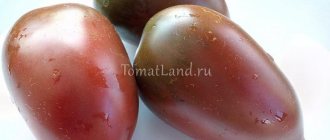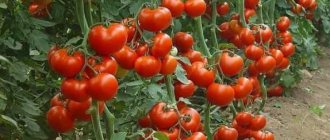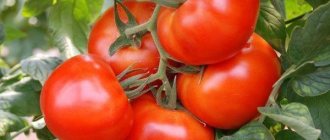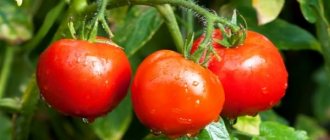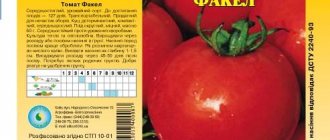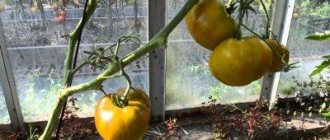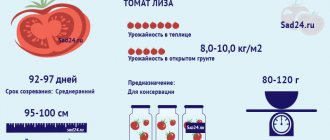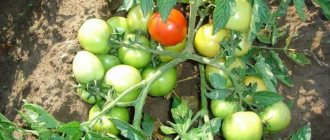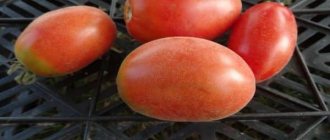Tomatoes New to Transnistria are no longer a novelty in our gardens; they were created back in 1967. Since then, the variety has gained well-deserved popularity due to its optimal combination of excellent taste, yield and disease resistance.
| Height | Landing location | Ripening time | Fruit color | Fruit size | Origin | Fruit shape |
| short | Open ground | Mid-early | Reds | Average | Variety | Plum-shaped or oval |
Description of tomatoes New from Transnistria
The determinate tomato variety Novinka Pridnestrovie is not standard. Shrubs can reach a height of 0.4-0.8 m. The plant stops developing after approximately 5 clusters are formed on it. The very first brush on the bush appears after 5 or 6 leaves, and the rest appear after every 2 leaves.
The shrubs have medium foliage. The foliage of this variety can grow to medium to large sizes. It is painted in a pleasant bright green color. This variety is characterized by short, simple-looking inflorescences consisting of 5 or 6 flowers. The first inflorescence is formed above the seventh leaf, and the next ones every 1-2 leaves. 5 or 6 tomatoes are formed on one brush.
Description and characteristics of the variety
The new products from Transnistria are determinate type tomatoes, so after about 5 clusters are formed, growth stops. Tomato bushes grow to about 80-90 cm in height. Like other tomatoes of this type, New Transnistrian tomatoes require gartering and the mandatory removal of excess shoots. If you take tomato cuttings in time, this will prevent you from overloading the plant with fruits and will contribute to the rapid ripening of already established tomatoes.
This is a plant with many medium-sized leaves. It has a simple inflorescence with about 5-6 ovaries. The tomato bears fruit well; on one bush you can find 10, 15, 20 or more fruits. Depending on what care and conditions are provided to the plant.
Characteristics of tomato fruits New from Transnistria:
- tomatoes weighing about 50-100 grams;
- elongated cylindrical shape, oblong;
- color – red;
- pleasant, tomato aroma;
- tomatoes are dense and juicy.
Pros and cons of the variety
The main feature of Novelty Transnistria tomatoes is a large number of advantages and the absence of negative aspects. Experienced gardeners have a strong and extremely positive opinion about this variety of tomatoes. This species has no objectively significant disadvantages.
So, the advantages of tomato, which are especially highlighted by its “users”:
- synchronous ripening of fruits, which allows you to harvest a large amount of crop at one time and grow tomatoes on an industrial scale;
- high yield rates;
- excellent taste;
- immunity to most diseases;
- the fruits tolerate transportation favorably due to their thick skin, which also does not crack;
- can be stored for a long time - up to 2 months.
Characteristics of tomato
Productivity and fruiting
Based on the description of the variety and technical characteristics, we can say that the Novinka Transnistria tomato is a mid-early one. Vegetables ripen approximately 3 months after the first shoots sprout. About 400-900 centners of fruit can be collected from one hectare of soil.
Plants of this variety can be grown both in open ground and in greenhouse conditions.
Area of application of fruits
Tomatoes of the Novinka Transnistria variety can be used for a variety of purposes. They are great for fresh consumption and preparing various dishes. Vegetables can be used to make fresh salads, stews, soups, juices, etc. The fruits of this variety are ideal for canning for the winter, as their small size makes it easy to fit them into a liter or three-liter jar.
Tomatoes can be stored for approximately 2 months. They are able to withstand transportation over long distances.
Resistance to diseases and pests
Due to the fact that the New Transnistria tomato is intended for cultivation in open soil, it is highly resistant to the influence of pathogens. This variety is very hardy and unpretentious to cultivation conditions.
Advantages and disadvantages of the variety
Tomatoes of this variety have a large number of positive aspects, which include:
- good yield;
- high taste and excellent aroma;
- the ability to grow plants both in open soil and in a greenhouse;
- crop resistance to diseases and insect pests;
- attractive appearance;
- convenient form for canning;
- the ability to transport vegetables over long distances;
- simultaneous ripening of tomatoes;
- the fruits do not spoil for a long time.
The New Transnistria tomato variety does not have any visible negative qualities.
Pros and cons of the variety
pros
- high productivity;
- amicable maturation;
- ease of care;
- resistance to diseases and temperature fluctuations;
- long shelf life and good transportation;
- versatility in application;
- suitable for whole canning;
- early ripening;
- high taste and external characteristics.
Minuses
- the need to garter the bush.
Growing rules
Planting seedlings
It is recommended to plant tomato seeds of the New Transnistria variety for seedlings after the 20th of March. In this case, light and temperature standards must be observed. Seeds should not be planted for seedlings before mid-March. Since the days are short, the seedlings will look sickly due to lack of light.
Planting material must be sown approximately 2 months before moving the seedlings to a permanent location. Sprouts appear fairly quickly (about a week after sowing). Therefore, the approximate period of time for seedlings to remain on window sills is 45-55 days (from the appearance of the first shoots).
The place for keeping seedlings should be well-lit and warm (18-24°C during the day, 12-14°C at night). In addition, it must have high humidity; the seedlings must be sprayed with water 2 times a day.
Before planting seeds for seedlings, they must be disinfected along with the soil.
Attention! Seeds and ready-made soil mixture for vegetables, which are sold in specialized stores, do not require preparation or disinfection
To eliminate the infection, use a manganese solution (1 g of substance per 0.1 liter of water). The planting material must be wrapped in gauze cloth soaked in this liquid. It should remain in solution for about a third of an hour.
To disinfect the soil, you can bake it in the oven (quarter of an hour at 180°C) or heat it in the microwave (2 minutes at 850 power).
Stages of sowing seeds for seedlings:
- Fill the seedling container with pre-prepared moist soil and make small depressions in it (about 1 cm deep). There should be a distance of 1-2 cm between the pits.
- Place planting material in the holes and cover with soil.
- Cover the container with soil with film or glass.
- Place it on the windowsill.
Tomato transplant
When the first clusters of flowers appear on the sprouts, this means that after about 2 weeks they need to be transplanted to a permanent place. Seedlings should be planted in a greenhouse in mid-May, in open soil - in early June.
There should be a distance of 0.3-0.4 m between young plants both in open soil and in the greenhouse. The soil must be fertile, mixed with peat or humus. It should be prepared in the fall: dug up along with compost, ash and eggshells.
Transplantation should be done on a cool or cloudy day. The central stem of the sprout must be buried 1-2 cm. After 3-5 days, the root system of the seedlings will begin to become stronger and more powerful.
After planting the sprouts, they must be watered with warm water.
Subsequent care for tomatoes
This tomato variety requires standard care. The plant needs to be watered and fed.
Watering the soil should be moderate. One bush should require approximately 1.5-2 liters of water. Depending on weather conditions, this should be done about twice a week. Water the soil should be in the morning or evening, when the sun is not yet too high.
Shrubs need to be fed several times a season. It is best to use natural or mineral fertilizers for this purpose.
Important! If the foliage of the plant has acquired a purple color, the soil must be fertilized with substances that contain phosphorus.
Also, we must not forget to remove weeds around the tomato bushes.
Disease susceptibility
Adapted for growing outdoors and therefore highly resistant to tomato diseases and pests, it is very unpretentious and hardy.
Before planting the plant in open ground, it is recommended to treat the soil with preparations against late blight.
If a tomato is attacked by harmful insects, you can get rid of them by using the most common insecticidal preparations that can be found in any garden store.
Planting and care
Growing “New Transnistria” does not have any special features. Grown by seedling method. Seeds are planted in prepared and heated soil 55-65 days before planting. Therefore, the timing must be calculated taking into account the weather conditions of the region. It is best to water the seedlings with warm water.
Before planting in the ground, the plant should be hardened off. To make it easier for the plant to endure transplantation and take root in a new place.
The plant needs staking to a support and pinching. The bushes are planted at a distance of 50 cm from each other. In total, no more than 3 plants are placed per 1 m2. Watering as necessary, loosening and fertilizing.
The Transnistrian variety is formed into 3-4 stems. Timely implementation of agrotechnical work can affect the volume of the harvest, significantly increasing it.
Diseases and pests
Tomatoes “New Transnistria” have stable immunity to diseases that affect plants of the nightshade family. However, bushes need prevention from late blight. 2-3 grams of copper sulfate are diluted in 3 liters of hot water. After the solution has cooled, the plants are sprayed with it.
There is also a second method - 1 tablet of trichopolum is diluted in a liter of water and sprayed on the seedlings.
Treatment with insecticidal preparations will help protect “New Transnistria” tomatoes from harmful insects.
Growing tomatoes
The “New Transnistria” variety is grown by planting seedlings.
How to prepare seeds?
Before sowing, you should carefully sort out the planting material, discarding damaged and deformed seeds. For better germination, it is recommended to soak the seeds for 10-12 hours in a solution of potassium permanganate. Also, seeds are often treated with special growth stimulants.
Breeders from the Pridnestrovian Research Institute presented new varieties and hybrids of vegetables:
Sowing seed material
Seeds are planted for seedlings approximately 55-60 days before the planned transfer of plants to a permanent place of growth.
The containers are filled with a special nutrient substrate. The seed is planted into the soil to a depth of 1.5-2 cm.
The soil is covered with polyethylene or thin glass. The container with future seedlings is placed in a warm, dark place.
After germination, the plants are placed in a well-lit room.
Seedlings should be watered regularly with warm, settled water.
Rules for planting seedlings
Seedlings are planted in open ground after warm weather sets in - in early June. Tomatoes can be transferred to greenhouses in mid-May. Bushes are planted at a distance of 50 cm from each other. For 1 sq. No more than 3-4 plants are placed per meter.
After the first true leaves appear, the plants are picked. The seedlings are placed in separate containers or pots with drainage holes at the bottom.
Harvest volume and application
Since tomatoes ripen almost simultaneously, they can be grown on an industrial scale. From 1 sq. meter you can collect 8-10 kg of fruit. One hectare on average brings about 900 centners.
Because tomatoes are approximately the same size, they are great for canning. For this reason, a large number of gardeners choose this variety for cultivation.
From tomatoes of the “New Transnistria” variety you can prepare sauces, juices, and also prepare preserves.
Reviews from summer residents regarding the variety
Useful information can also be gleaned from reviews left by people who have experience growing this variety. Among them you can find practical tips and recommendations.
- Otmakhova Lyudmila, 36 years old:
I became acquainted with this variety of tomatoes in deep childhood. Her mother raised them. According to tradition, Lyudmila grows tomatoes of this variety herself and is very pleased with them. The characteristics of the tomatoes are quite satisfactory. Since she rated the taste as excellent, tomatoes are well suited as an ingredient for fresh salads or preparations. But she finds pickled tomatoes the most delicious. When boiling water is poured into jars, the peel is not subject to cracking. Planting is done in open ground. - Yulia Petrushina, 33 years old:
I decided to grow this particular variety because I was attracted by the qualities and characteristics of tomatoes. As a result, all the described features were confirmed. The cultivation procedure took place in greenhouse conditions, since in the Kirov region. tomatoes of this variety simply do not have time to ripen. Some plants were infected with late blight and died. It is also worth noting that the early ripening of the fruits was a special joy.
The positive characteristics of the “New Transnistria” tomato variety once again prove that this crop is not in vain considered one of the most popular among many summer residents.
Positive and negative sides
The variety has practically no negative properties, but has many positive ones.
- Harmonious ripening of fruits.
- High yield.
- Resistant to most diseases.
- Tomatoes are very shelf-stable and suitable for transportation.
- The fruits are not subject to cracking.
Read also: Rkatsiteli grapes - description of the variety with photos; beneficial properties and harm
Disease susceptibility
Since the tomato was bred for open ground, it is not exposed to pathogens. Being very hardy and unpretentious.
See also
Characteristics and description of the Beef tomato, what kind of variety it is, its yieldRead
If a plant suffers from attacks by insect pests, it is treated with preparations that are sold in specialized stores.
Harvest volume and application
Due to the fact that tomatoes ripen at the same time, this species is grown on an industrial scale. It is easier to clean and easy to care for. From 1 m2 you get from 8 to 10 kg of tomatoes. Productivity per hectare up to 900 centners.
The same size of tomatoes makes them most convenient for home canning. Therefore, many summer residents, once faced with this variety, will not exchange it for any other.
Whole-fruit canning, preparation of sauces, juices and tomatoes, this is not the entire list of fruit uses. They are also consumed fresh.
Tomatoes are used for the industrial production of canned food, tomato paste and more.
Tomato 'New Transnistria'
Latin name: solanum lycopersicum 'novinka pr />
Main genus: Tomato
| Size |
|
| Productivity |
|
| Ripening period |
|
| Soil type |
|
| Growing method |
|
| Purpose of fruits |
|
| Disease resistance |
|
| Soil ph requirements |
|
| Life form |
|
| Shape of fruits/stems/roots and tubers/heads |
|
| Size of fruits/stems/roots and tubers/heads |
|
| Cultivation region by origin |
|
| Vitamin content |
|
| Color of fruits/roots and tubers | |
| Peel thickness |
|
| Frost resistance |
|
| Drought resistance |
|
| Decorative value |
|
| Taste of fruits |
|
| Shelter for the winter |
|
| Pest resistance |
|
| Habit |
|
| Keeping quality |
|
| Parthenocarpic |
|
| Branching pattern |
|
| Density and character of the pulp |
|
Expand all properties
Description of the plant:
Tomato 'New Transnistria' is a variety bred by the Transnistrian Research Institute of Agriculture. Approved for use in the Central Black Earth, North Caucasus, Middle Volga and Far Eastern regions in 1967.
Recommended for growing in open ground.
Dimensions and growth form:
The 'New Transnistria' variety is represented by determinate plants with a main stem height of 40–80 cm. The foliage is intense. The leaf is ordinary, medium-sized and large, green, slightly corrugated.
The inflorescence is simple, short (5–8 cm). The first inflorescence is formed above the 6-7th leaf, the subsequent ones - after 1-2 leaves. On the main stem, 3–4 clusters with 5–6 fruits are formed.
Fruit:
Size, shape and color:
The fruit is cylindrical, small to medium in size, with an average weight of 36–56 g. The surface is smooth with edges. The color of the unripe fruit is greenish-whitish, the mature one is red. The number of slots is 2, the location is correct.
The taste of the fruit is good.
Ripening time and yield:
Tomato 'New Transnistria' is a mid-early variety. The period from full germination to fruit ripening is 104–130 days. Productivity is 4.1–9.5 kg/m2.
Directions for use:
Recommended for fresh consumption and for whole-fruit canning.

